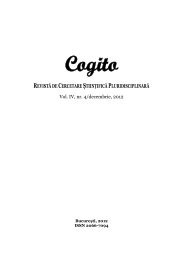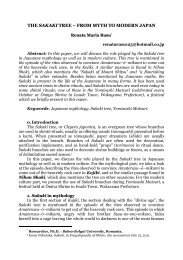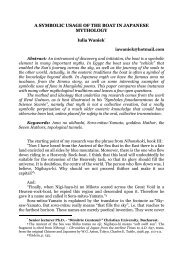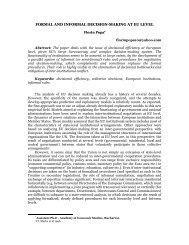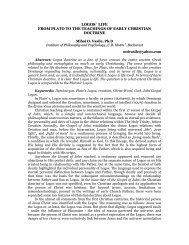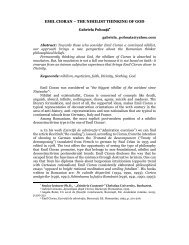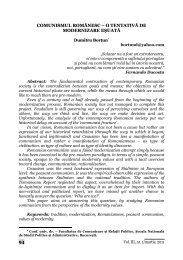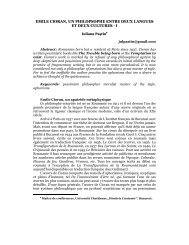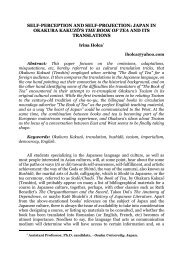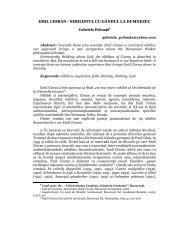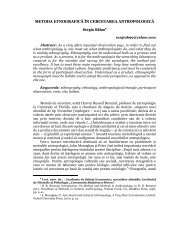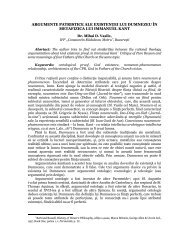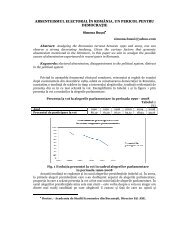the female body in enchi fumiko's literature. a gender ... - cogito
the female body in enchi fumiko's literature. a gender ... - cogito
the female body in enchi fumiko's literature. a gender ... - cogito
Create successful ePaper yourself
Turn your PDF publications into a flip-book with our unique Google optimized e-Paper software.
THE FEMALE BODY IN ENCHI FUMIKO’S LITERATURE. A<br />
GENDER PERSPECTIVE<br />
Monica Tamaş <br />
valley.below@gmail.com<br />
Abstract: One of <strong>the</strong> prom<strong>in</strong>ent <strong>female</strong> writers of <strong>the</strong> postwar period,<br />
Enchi Fumiko (1905-1986) succeeded <strong>in</strong> describ<strong>in</strong>g <strong>the</strong> modern real woman 1 <strong>in</strong><br />
her works as she delved <strong>in</strong>to <strong>the</strong> dynamics of <strong>gender</strong> <strong>in</strong> modern society. By do<strong>in</strong>g<br />
so, she criticized <strong>the</strong> persistence of values belong<strong>in</strong>g to <strong>the</strong> patriarchal system<br />
that preserve <strong>the</strong> idea of <strong>gender</strong> difference to <strong>the</strong> detriment of women.<br />
Enchi challenged <strong>the</strong> idea of a purportedly standard universal <strong>body</strong> that is<br />
an idealized composite of <strong>the</strong> “best” features of real bodies and to which women<br />
are be<strong>in</strong>g subjected to. As some fem<strong>in</strong>ists have argued, for women, <strong>the</strong> <strong>body</strong> is a<br />
primary signifier of <strong>the</strong> self to <strong>the</strong> outside world and <strong>the</strong> l<strong>in</strong>ks between identity<br />
and embodiment are more explicit for women than for men. This should be taken<br />
as one of <strong>the</strong> ma<strong>in</strong> reasons why Enchi felt <strong>the</strong> need to explore <strong>the</strong> characters<br />
psyche by relat<strong>in</strong>g it to <strong>the</strong> <strong>female</strong> <strong>body</strong>.<br />
In Enchi’s works, liv<strong>in</strong>g with a radically unpredictable <strong>body</strong> or a <strong>body</strong> that<br />
has lost functions or parts calls <strong>in</strong>to question <strong>the</strong> stability and cont<strong>in</strong>uity of<br />
identity. The <strong>female</strong> characters <strong>in</strong> Enchi’s novels might not express <strong>the</strong>ir<br />
emotions, but <strong>the</strong>ir anguish manifests itself on <strong>the</strong> level of <strong>the</strong>ir bodies. That is to<br />
say, psychological suffer<strong>in</strong>g is be<strong>in</strong>g transformed <strong>in</strong>to a corporeal suffer<strong>in</strong>g. In<br />
this essay I am analyz<strong>in</strong>g <strong>the</strong> mean<strong>in</strong>g, characteristics and ways of portrayal of<br />
<strong>the</strong> <strong>female</strong> <strong>body</strong> <strong>in</strong> Enchi Fumiko’s works while referr<strong>in</strong>g to former critical<br />
studies and modern <strong>gender</strong> studies.<br />
Keywords: Enchi Fumiko, women, <strong>gender</strong>, patriarchal authority, old age<br />
and <strong>the</strong> <strong>body</strong>.<br />
1. Introduction<br />
One of <strong>the</strong> prom<strong>in</strong>ent <strong>female</strong> writers of <strong>the</strong> postwar period, Enchi Fumiko<br />
(1905-1986) succeeded <strong>in</strong> describ<strong>in</strong>g <strong>the</strong> modern “real woman” <strong>in</strong> her works, as<br />
she delved <strong>in</strong>to <strong>the</strong> dynamics of <strong>gender</strong> <strong>in</strong> modern society. By do<strong>in</strong>g so, she<br />
criticized <strong>the</strong> persistence of values belong<strong>in</strong>g to <strong>the</strong> patriarchal system that<br />
preserve <strong>the</strong> idea of <strong>gender</strong> difference to <strong>the</strong> detriment of women. In order to<br />
represent <strong>the</strong> “real woman” <strong>in</strong> fiction, Enchi used her own experiences or <strong>in</strong>spired<br />
herself from <strong>the</strong> stories of o<strong>the</strong>r women, <strong>in</strong>clud<strong>in</strong>g her maternal grandmo<strong>the</strong>r<br />
whose story she depicted <strong>in</strong> <strong>the</strong> novel Onnazaka. This paper focuses on <strong>the</strong><br />
characteristics of <strong>the</strong> <strong>female</strong> <strong>body</strong> <strong>in</strong> Enchi’s fiction and explores <strong>the</strong> ways of<br />
portrayal and mean<strong>in</strong>gs of <strong>the</strong> <strong>female</strong> <strong>body</strong> <strong>in</strong> a <strong>gender</strong>ed milieu, as Japanese<br />
society is described <strong>in</strong> Enchi’s works.<br />
Researcher Ph.D. candidate, - Osaka University, Japan.<br />
1 Noguchi Hiroko, Enchi Fumiko no kiseki, Osaka: Izumi sho<strong>in</strong>, 2003, p. 2.
Throughout this essay I will show how many of Enchi’s <strong>female</strong> characters are<br />
strongly represented by <strong>the</strong>ir bodies <strong>in</strong> <strong>the</strong>ir becom<strong>in</strong>g while be<strong>in</strong>g denied access<br />
to or recognition through <strong>the</strong> world of thought. More, <strong>female</strong> characters are be<strong>in</strong>g<br />
represented by a <strong>body</strong> that is changeable and perishable and <strong>the</strong> decay<strong>in</strong>g <strong>female</strong><br />
<strong>body</strong> is portrayed as one no longer fit to live <strong>in</strong>side <strong>the</strong> system because it doesn’t<br />
fulfill <strong>the</strong> parameters of <strong>the</strong> sexualized ideal <strong>female</strong> <strong>body</strong> with<strong>in</strong> social mentality.<br />
Subsequently, Enchi’s <strong>female</strong> characters are placed outside <strong>the</strong> social system or at<br />
its periphery. Moreover, it appears that <strong>in</strong> Enchi’s novels old age by itself is a<br />
peripheral territory.<br />
As some fem<strong>in</strong>ists have argued, for women, <strong>the</strong> <strong>body</strong> is a primary signifier of<br />
<strong>the</strong> self to <strong>the</strong> outside world and <strong>the</strong> l<strong>in</strong>ks between identity and embodiment are<br />
more explicit for women than for men 2 . In contrast to Western thought, Asian<br />
philosophy tends to promote <strong>the</strong> <strong>in</strong>tegration of <strong>body</strong>/matter and m<strong>in</strong>d, a desired<br />
unity that has to be acquired. The Japanese landscape of thought is built around<br />
<strong>the</strong> term kokoro, a concept best translated as “<strong>the</strong> embodied m<strong>in</strong>d” 3 , a concept<br />
fundamentally different from <strong>the</strong> Western m<strong>in</strong>d. Among <strong>the</strong> representative<br />
modern Japanese philosophers who have dealt with <strong>the</strong> m<strong>in</strong>d/<strong>body</strong> <strong>the</strong>ory <strong>in</strong><br />
Asian and European mentality, Ichikawa Hiroshi and Yuasa Yasuo have<br />
constructed <strong>the</strong>ir bodily scheme as a cont<strong>in</strong>uum or nondualism 4 . These models<br />
are relevant for Enchi’s portrayal of women and for <strong>the</strong> dynamics of <strong>gender</strong> that<br />
Enchi describes <strong>in</strong> her novels. They help identify <strong>the</strong> framework of Enchi’s bodily<br />
scheme and expla<strong>in</strong> <strong>the</strong> reasons why Enchi felt <strong>the</strong> need to explore <strong>the</strong> characters<br />
psyche by relat<strong>in</strong>g it to <strong>the</strong> <strong>female</strong> <strong>body</strong>. First, Enchi’s <strong>female</strong> characters are<br />
isolated from <strong>the</strong>ir male counterparts <strong>in</strong> what looks like a m<strong>in</strong>d/<strong>body</strong> dualism<br />
scenario where women are be<strong>in</strong>g represented by <strong>the</strong>ir bodies. As a second stage <strong>in</strong><br />
<strong>the</strong>ir development, though not all characters achieve this stage, <strong>the</strong> women <strong>in</strong><br />
Enchi’s novels have to <strong>in</strong>tegrate m<strong>in</strong>d with <strong>body</strong>, that is, to unify spirit and matter<br />
as a whole.<br />
Fur<strong>the</strong>rmore, it is necessary to observe that <strong>the</strong>re is a close relationship<br />
between Enchi’s biography and her fiction, regard<strong>in</strong>g issues of sickness and<br />
corporeal suffer<strong>in</strong>g. Enchi herself had suffered two major surgeries (a<br />
hysterectomy and a mastectomy) and had experienced temporary bl<strong>in</strong>dness, teeth<br />
extraction and dentures throughout her lifetime, ailments she dealt with <strong>in</strong> her<br />
writ<strong>in</strong>g as well.<br />
Enchi demolished <strong>the</strong> myth of <strong>the</strong> perfect <strong>female</strong> <strong>body</strong> to which women are<br />
be<strong>in</strong>g subjected to. She raised issues related to corporeality that have not been<br />
previously dealt with with<strong>in</strong> <strong>the</strong> Japanese literary tradition and she represented<br />
women’s relationship with <strong>the</strong>ir bodies by tak<strong>in</strong>g up elements that are be<strong>in</strong>g<br />
2 Fem<strong>in</strong>ist philosophers and scholars like Judith Butler, Elizabeth Grozs, Michelle Boulous<br />
Walker and Elisabeth V. Spelman analyzed <strong>the</strong> implications of <strong>the</strong> m<strong>in</strong>d/<strong>body</strong> dualism po<strong>in</strong>t<strong>in</strong>g out<br />
that associations of m<strong>in</strong>d with mascul<strong>in</strong>ity and <strong>body</strong> with fem<strong>in</strong><strong>in</strong>ity are prevalent <strong>in</strong> European<br />
philosophy.<br />
3 Gudykunst, William B. (ed.) Communication <strong>in</strong> Japan and <strong>the</strong> United States, Albany: State<br />
University of New York, 1993, p. 64<br />
4 See Kasulis, Thomas P.; Ames, Roger T.; Dissanayake Wimal (ed.) Self As Body In Asian<br />
Theory And Practice, Albany, N.Y. : State University of New York Press, 1993
purported as be<strong>in</strong>g characteristic of <strong>the</strong> <strong>female</strong> <strong>body</strong> or of <strong>the</strong> devaluation of it.<br />
Among <strong>the</strong>se, she <strong>in</strong>troduced through her writ<strong>in</strong>gs elements such as menstrual<br />
blood, <strong>the</strong> loss of sex organs, childbirth, abortion and <strong>the</strong> devaluation of <strong>the</strong><br />
<strong>female</strong> <strong>body</strong> because of age.<br />
I would like to discuss motifs like <strong>the</strong> abjection of <strong>the</strong> maternal <strong>body</strong> <strong>in</strong> works<br />
such as Masks (Onnamen, 1958) and Black God (Kuroi kami, 1956), <strong>the</strong> repressed<br />
<strong>female</strong> sexuality <strong>in</strong> works such as Earr<strong>in</strong>gs (Mimiyōraku, 1957) and Enchantress<br />
(Yō, 1956), <strong>the</strong> fear of corporeal difference and transformation <strong>in</strong> Days of Hunger<br />
(Himojii tukihi, 1954) and Enchantress and <strong>the</strong> wretchedness of old age <strong>in</strong> The<br />
Spouses (Fūfu, 1962). Consider<strong>in</strong>g <strong>the</strong> subjectification of women with<strong>in</strong> <strong>the</strong><br />
phallocentric system of <strong>the</strong> patriarchal Japanese society as it is represented <strong>in</strong><br />
Enchi’s novels, I would like to analyze <strong>in</strong> my paper how <strong>the</strong> oppression of women<br />
by men is be<strong>in</strong>g projected on <strong>the</strong> <strong>female</strong> <strong>body</strong> <strong>in</strong> Enchi’s works.<br />
2. Gender discourse and corporeality <strong>in</strong> Enchi’s fiction<br />
Despite <strong>the</strong> fact that Enchi did not necessarily def<strong>in</strong>e herself as a fem<strong>in</strong>ist<br />
writer, she addresses <strong>in</strong> her writ<strong>in</strong>gs <strong>the</strong> issue of <strong>gender</strong> relationships <strong>in</strong> Japanese<br />
society. Enchi placed <strong>female</strong> characters <strong>in</strong> <strong>the</strong> center of her stories and most of<br />
<strong>the</strong>se characters were depicted with<strong>in</strong> an antagonistic and dysfunctional<br />
relationship with <strong>the</strong>ir male counterparts. Look<strong>in</strong>g for <strong>the</strong> strength of women<br />
“reborn” after Japan’s loss <strong>in</strong> <strong>the</strong> war, Enchi sought to illustrate <strong>the</strong> true life of<br />
<strong>the</strong>se Japanese women. And although she isolated <strong>female</strong> characters from <strong>the</strong>ir<br />
male counterparts <strong>in</strong> some of her writ<strong>in</strong>gs, her characters could not have escaped<br />
<strong>the</strong> <strong>gender</strong> codes enforced by <strong>the</strong> patriarchal society <strong>in</strong> which <strong>the</strong>y live. This<br />
confrontation with patriarchal values is <strong>the</strong> arena of <strong>the</strong>ir struggle to affirm <strong>the</strong>ir<br />
identity or <strong>the</strong> space of <strong>the</strong>ir submission. Because, as Judith Butler expla<strong>in</strong>s it, “it<br />
becomes impossible to separate out “<strong>gender</strong>” from <strong>the</strong> political and cultural<br />
<strong>in</strong>tersections <strong>in</strong> which it is <strong>in</strong>variably produced and ma<strong>in</strong>ta<strong>in</strong>ed” 5<br />
In this context, we could say that <strong>in</strong> Enchi Fumiko’s <strong>literature</strong> “<strong>gender</strong><br />
trouble” orig<strong>in</strong>ates from “<strong>body</strong> trouble”, <strong>in</strong> o<strong>the</strong>r words, that <strong>the</strong> Self is threatened<br />
by <strong>the</strong> <strong>in</strong>stability of <strong>the</strong> <strong>body</strong> <strong>in</strong> which important characteristics of <strong>the</strong> <strong>gender</strong><br />
reside.<br />
2.1. Earr<strong>in</strong>gs: <strong>the</strong> loss of sexual organs and recover<strong>in</strong>g one’s<br />
sexual identity.<br />
For example, Takiko, <strong>the</strong> middle aged hero<strong>in</strong>e of Earr<strong>in</strong>gs is a woman <strong>in</strong> <strong>the</strong><br />
middle of a sexual identity crisis. After her hysterectomy, Takiko is seized by a<br />
“monstrous fear” 6 . She feels that “[w]ithout any pa<strong>in</strong> or fever and without her<br />
know<strong>in</strong>g when and where it came from, <strong>the</strong> illness spread its roots <strong>in</strong>side her <strong>body</strong><br />
and it started devour<strong>in</strong>g <strong>the</strong> cells” 7 and th<strong>in</strong>ks that “an <strong>in</strong>visible enemy was hid<strong>in</strong>g<br />
<strong>in</strong> her <strong>body</strong>.” 8 She <strong>the</strong>n expla<strong>in</strong>s to her husband: “when <strong>the</strong>y removed <strong>the</strong> womb,<br />
5 Judith Butler, Gender Trouble, New York : Routledge, 2008, p. 4-5.<br />
6 Enchi Fumiko, Enchi Fumiko Zenshū, 2:367, Tokyo: Sh<strong>in</strong>chōsha, 1977-1978; Enchi Fumiko<br />
Zenshū henceforth abbreviated as EFZ.<br />
7 EFZ, 2:367<br />
8 EFZ, 2:367
<strong>the</strong>y gave <strong>the</strong> cavity left beh<strong>in</strong>d a pa<strong>the</strong>tic name; <strong>the</strong>y called it a “dead open<strong>in</strong>g” 9 .<br />
Feel<strong>in</strong>g that she is no longer a woman she rejects her husband’s and her friend<br />
Takanashi’s advances but Takanashi’s encouragements arouse her senses and<br />
br<strong>in</strong>g back <strong>the</strong> woman <strong>in</strong>side. She <strong>the</strong>n proceeds on to seduc<strong>in</strong>g her associate, <strong>the</strong><br />
jeweler Jirō, but without giv<strong>in</strong>g him any chance to confess his feel<strong>in</strong>gs for her.<br />
Beauty - where wholeness of <strong>the</strong> <strong>body</strong> is seen as be<strong>in</strong>g <strong>in</strong>dispensable - and <strong>the</strong><br />
capacity of bear<strong>in</strong>g children are essential traits of <strong>the</strong> commonly accepted image of<br />
<strong>the</strong> “Woman”. The lack of sexual organs might blur <strong>the</strong> boundaries between <strong>the</strong><br />
sexes, but despite <strong>the</strong>ir existence or non-existence, <strong>gender</strong> can def<strong>in</strong>e itself outside<br />
<strong>the</strong> borders of corporeality. Takiko manages to recover her sexual identity and<br />
th<strong>in</strong>k of herself as be<strong>in</strong>g “a woman made out of <strong>the</strong> rib of a man” 10 , <strong>in</strong> o<strong>the</strong>r words,<br />
as perfect as Eve, <strong>the</strong> orig<strong>in</strong>al woman.<br />
2.2. Male chauv<strong>in</strong>ism and <strong>the</strong> <strong>female</strong> <strong>body</strong><br />
Tension and <strong>in</strong>equality <strong>in</strong> relationships between men and women are typical<br />
for Enchi’s fiction. Female characters possess <strong>in</strong>complete bodies and are<br />
represented by <strong>the</strong>m. By confront<strong>in</strong>g <strong>the</strong>mselves with <strong>the</strong> changes that happen <strong>in</strong><br />
<strong>the</strong>ir bodies like loss or malfunction, <strong>the</strong> <strong>female</strong> characters come to have an<br />
existence <strong>in</strong> which <strong>the</strong>ir corporeality is <strong>the</strong> ma<strong>in</strong> – if not <strong>the</strong> only – characteristic.<br />
Completely opposite to this, male characters are be<strong>in</strong>g characterized by <strong>the</strong>ir<br />
cognitive abilities and have a strong superiority complex towards <strong>the</strong>ir <strong>female</strong><br />
counterparts. The male characters <strong>in</strong> Black God, The Spouses, Masks are<br />
professors or doctors, whereas <strong>the</strong> <strong>female</strong> characters Mio, Ikuyo and Harume are<br />
be<strong>in</strong>g placed <strong>in</strong> an <strong>in</strong>ferior position and are women suffer<strong>in</strong>g because of changes<br />
which happen to <strong>the</strong>ir bodies: ailments or natural transformations. Despite that,<br />
while it may be true that <strong>the</strong>se <strong>female</strong> characters are represented almost<br />
exclusively through <strong>the</strong>ir corporeality, it is not necessarily true that <strong>the</strong>ir male<br />
counterparts possess a superior nature <strong>in</strong> comparison.<br />
Judith Butler observed that “In <strong>the</strong> philosophical tradition that beg<strong>in</strong>s with<br />
Plato and cont<strong>in</strong>ues through Descartes, Husserl, and Sartre, <strong>the</strong> ontological<br />
dist<strong>in</strong>ction between soul (consciousness, m<strong>in</strong>d) and <strong>body</strong> <strong>in</strong>variably supports<br />
relations of political and psychic subord<strong>in</strong>ation and hierarchy. […] The cultural<br />
associations of m<strong>in</strong>d with mascul<strong>in</strong>ity and <strong>body</strong> with fem<strong>in</strong><strong>in</strong>ity are well<br />
documented with<strong>in</strong> <strong>the</strong> field of philosophy and fem<strong>in</strong>ism.” 11 Fur<strong>the</strong>rmore,<br />
contemporary fem<strong>in</strong>ist <strong>the</strong>orists like Simone de Beauvoir, Monique Wittig and<br />
Luce Irigaray are reanalyz<strong>in</strong>g <strong>the</strong> antagonistic duality between men and women<br />
that works with <strong>the</strong> concepts of m<strong>in</strong>d and <strong>body</strong>. In <strong>the</strong> same way, Enchi defies this<br />
duality and, while keep<strong>in</strong>g a critical consciousness regard<strong>in</strong>g <strong>gender</strong> roles <strong>in</strong><br />
Japan, she advocates for improvement of <strong>the</strong> situation of women <strong>in</strong> Japanese<br />
society.<br />
It becomes obvious that while <strong>the</strong> social background of Enchi’s character<br />
constellations is a society characterized by chauv<strong>in</strong>ism and male dom<strong>in</strong>ance, a<br />
9 EFZ, 2:368<br />
10 EFZ, 2:372<br />
11 Judith Butler, Gender Trouble, New York : Routledge, 2008, p. 17
comparison between men and women <strong>in</strong>side <strong>the</strong>se conf<strong>in</strong>es could not be<br />
o<strong>the</strong>rwise but biased. None<strong>the</strong>less, <strong>the</strong>re are also <strong>female</strong> characters who disobey<br />
<strong>the</strong> <strong>in</strong>ternal rules of patriarchy and, by do<strong>in</strong>g so, <strong>the</strong>y come to affirm <strong>the</strong>ir identity.<br />
In Masks, Mieko, a poetess and researcher of Japanese classical <strong>literature</strong>, plans<br />
and accomplishes a scheme of revenge towards her late husband who had<br />
betrayed her. In order for Mieko to carry out her plot, she uses men who become<br />
mere tools <strong>in</strong> <strong>the</strong> hands of a mastered puppeteer.<br />
In Black God we meet a double-edged <strong>in</strong>equality between <strong>the</strong> male and<br />
<strong>female</strong> characters. While Mio’s husband is an university researcher, he ends up<br />
be<strong>in</strong>g arrested by <strong>the</strong> police for <strong>the</strong>ft and he proves to be a kleptomaniac. Mio, who<br />
has lacked <strong>the</strong> power of decision regard<strong>in</strong>g her own pregnancy and child, f<strong>in</strong>ally<br />
manages to set herself free from <strong>the</strong> constra<strong>in</strong>ts of <strong>the</strong> patriarchal society she lives<br />
<strong>in</strong> and to ga<strong>in</strong> for herself <strong>the</strong> right to decide. Chigako, <strong>the</strong> ma<strong>in</strong> character from<br />
Enchantress as well envisions herself tak<strong>in</strong>g revenge on her husband who has<br />
constantly ignored her and <strong>the</strong>ir children throughout <strong>the</strong>ir marriage, be<strong>in</strong>g too<br />
absorbed <strong>in</strong> his hobby of be<strong>in</strong>g an art dealer. Chigako’s revenge is just a fantasy,<br />
but for her, whose existence is ma<strong>in</strong>ly ideal – she works as a translator of classical<br />
Japanese stories – this seems to be an adequate k<strong>in</strong>d of retribution.<br />
3. The scarred <strong>body</strong> and <strong>the</strong> scared Self<br />
In her essay “Bodies <strong>in</strong> Trouble” Krist<strong>in</strong> L<strong>in</strong>dgren draws attention to <strong>the</strong> fact<br />
that “[o]ur sense of a stable identity is dependent on an unchang<strong>in</strong>g,<br />
taken-for-granted <strong>body</strong>” 12 and ”[f]or many people, liv<strong>in</strong>g with a radically<br />
unpredictable <strong>body</strong>, or a <strong>body</strong> that has lost functions or parts, calls <strong>in</strong>to question<br />
<strong>the</strong> stability and cont<strong>in</strong>uity of identity.” 13 Accord<strong>in</strong>g to L<strong>in</strong>dgren, disease is not<br />
only a crisis of <strong>the</strong> <strong>body</strong>, but also a crisis of Self-identity. If it were to analyze<br />
Enchi’s writ<strong>in</strong>gs from this perspective, we have to say that <strong>in</strong> her works not only<br />
disease but also defects of <strong>the</strong> <strong>body</strong> and <strong>the</strong> <strong>body</strong>’s <strong>in</strong>stability are elements that<br />
shake <strong>female</strong> characters’ sense of identity and alter it. In order to overcome <strong>the</strong><br />
crisis of <strong>the</strong> Self, <strong>female</strong> characters have to face <strong>the</strong> changes that have occurred<br />
<strong>in</strong>side <strong>the</strong>ir bodies and come to terms with <strong>the</strong>m. For example, <strong>in</strong> order for <strong>the</strong><br />
ma<strong>in</strong> character of Black God to ga<strong>in</strong> <strong>the</strong> right of choice, that is, for her to affirm<br />
herself, she needs to admit and assimilate <strong>the</strong> existence of <strong>the</strong> child liv<strong>in</strong>g <strong>in</strong>side<br />
her <strong>body</strong> and to start perceiv<strong>in</strong>g this child as be<strong>in</strong>g her own possession, and not<br />
<strong>the</strong> possession of o<strong>the</strong>rs. In <strong>the</strong> same way <strong>the</strong> <strong>female</strong> characters from Enchantress<br />
and Earr<strong>in</strong>gs have to confront <strong>the</strong>mselves with <strong>the</strong> changeability of <strong>the</strong>ir bodies<br />
and to redef<strong>in</strong>e <strong>the</strong>ir sense of Self.<br />
It becomes obvious that Enchi Fumiko does not give <strong>in</strong>to <strong>the</strong> illusion of <strong>the</strong><br />
perfect “universal” <strong>body</strong>, but through her <strong>female</strong> characters she is actually<br />
challeng<strong>in</strong>g <strong>the</strong> preconceived idea that stands at <strong>the</strong> root of common evaluation of<br />
<strong>the</strong> human <strong>body</strong> and that has such a powerful relationship and <strong>in</strong>fluence to <strong>the</strong><br />
Self. This is <strong>the</strong> social paradigm <strong>in</strong> which Enchi’s characters are situated and<br />
12 L<strong>in</strong>dgren, Krist<strong>in</strong>, ”Bodies <strong>in</strong> Trouble” <strong>in</strong> Gender<strong>in</strong>g disability, ed. Smith, Hutch<strong>in</strong>son, New<br />
Brunswick, N.J.: Rutgers University Press, 2004, p. 150<br />
13 Ibid, p. 148
deprived of any control over <strong>the</strong>ir own corporeality. Accord<strong>in</strong>g to Ruth Barcan,<br />
“Differences between liv<strong>in</strong>g bodies are to be imag<strong>in</strong>ed as aberrations or<br />
exceptions to this abstract idea of a putatively “universal” <strong>body</strong>; age<strong>in</strong>g, blemishes<br />
and so on are conceived of as deviations from an ideal ra<strong>the</strong>r than equally typical<br />
variations with<strong>in</strong> a field.” 14<br />
This characteristic is strik<strong>in</strong>g <strong>in</strong> Enchi’s short novel Days of Hunger, a story<br />
that has at its background <strong>the</strong> chaotic social conditions at <strong>the</strong> end of World War II.<br />
Saku, <strong>the</strong> ma<strong>in</strong> character, is haunted throughout her life by <strong>the</strong> birthmark she has<br />
on her back, a small detail that will cause her to develop a strong complex of<br />
<strong>in</strong>feriority. Feel<strong>in</strong>g ashamed of her “flaw”, she rejects one by one <strong>the</strong> marriage<br />
proposals that she receives until she has passed <strong>the</strong> marriageable age. At last she<br />
f<strong>in</strong>ds herself compelled to give <strong>in</strong> to her matchmaker’s proposition of marriage.<br />
Saku spends her days fulfill<strong>in</strong>g her role as a duteous wife and tak<strong>in</strong>g care of her<br />
family, but one day she collapses over <strong>the</strong> washboard <strong>in</strong> her bathroom and dies.<br />
While it might not be considered a physical handicap, a birthmark is a sign of<br />
difference. Reject<strong>in</strong>g this difference (“special” spot) on her <strong>body</strong>, Saku ends up<br />
be<strong>in</strong>g <strong>in</strong> no way unlike any o<strong>the</strong>r common woman dur<strong>in</strong>g <strong>the</strong> gloomy after-war<br />
period, when all Japanese people were try<strong>in</strong>g striv<strong>in</strong>g to survive <strong>in</strong> spite of dire<br />
straits.<br />
The ma<strong>in</strong> character of Enchantress, Chigako, is a woman who is try<strong>in</strong>g to fight<br />
aga<strong>in</strong>st one of <strong>the</strong> imag<strong>in</strong>ed aberrations of <strong>the</strong> “universal” <strong>body</strong> as she attempts to<br />
turn back time and set back <strong>the</strong> process of age<strong>in</strong>g. A translator of Japanese classical<br />
<strong>literature</strong>, Chigako spends her days work<strong>in</strong>g and day-dream<strong>in</strong>g <strong>in</strong> a special room<br />
attached to <strong>the</strong> house where her husband is liv<strong>in</strong>g <strong>in</strong>. The short novel focuses on<br />
Chigako’s efforts to preserve her physical appearance – a youth lost for <strong>the</strong> eye that<br />
can be faked with <strong>the</strong> help of and rejuvenat<strong>in</strong>g cosmetics. None<strong>the</strong>less, Chigako is<br />
young at heart. She envisions herself dar<strong>in</strong>g an adventure with <strong>the</strong> student who<br />
passes by her house now and <strong>the</strong>n and <strong>in</strong> her daydream <strong>the</strong> borders between fantasy<br />
and <strong>the</strong> real world seem to melt, for one night Chigako and her husband are woken<br />
up by a young couple (supposedly her young Doppelgänger and her daydream<br />
partner) hugg<strong>in</strong>g at <strong>the</strong> gate of <strong>the</strong> house. It is <strong>in</strong>terest<strong>in</strong>g to observe how deep <strong>in</strong>to<br />
<strong>the</strong> world of fiction <strong>the</strong> character ventures: like <strong>the</strong> authors of Sarash<strong>in</strong>a Diary and<br />
The Kagerō Diary who have dealt with feel<strong>in</strong>gs of lonel<strong>in</strong>ess <strong>in</strong> <strong>the</strong>ir writ<strong>in</strong>gs,<br />
Chigako f<strong>in</strong>ds her balance <strong>in</strong> <strong>the</strong> world of fiction. She even goes as far as identify<strong>in</strong>g<br />
with Tsukumogami, <strong>the</strong> old woman <strong>in</strong> Tales of Ise who has an affair with a younger<br />
man. More precisely, Chigako, who has never known <strong>the</strong> moments of happ<strong>in</strong>ess that<br />
a woman could experience with a man, is aroused by <strong>the</strong> stories she has to translate<br />
and <strong>in</strong> spite of <strong>the</strong> dryness <strong>in</strong> her love life she rejoices <strong>in</strong> sensual excesses of <strong>the</strong> m<strong>in</strong>d.<br />
Confused, Chigako wonders to what purpose she is disguis<strong>in</strong>g her <strong>body</strong>. Spectacles,<br />
false teeth, cosmetics, soon enough false locks to cover her th<strong>in</strong>ned hair form a<br />
masquerade costume that transformed her <strong>in</strong>to an unrecognizable “creature”.<br />
Although she th<strong>in</strong>ks all her efforts to be fruitless, this transformation is necessary for<br />
<strong>the</strong> ambiguous space she is <strong>in</strong>habit<strong>in</strong>g. The entire construction of <strong>the</strong> house placed at<br />
<strong>the</strong> foot of <strong>the</strong> hill resembles a womb and Chigako’s bed resembles a coff<strong>in</strong>; <strong>the</strong> slope<br />
14 Barcan, Ruth. Nudity: A Cultural Anatomy. Oxford, New York: Berg, 2004, p. 35
is be<strong>in</strong>g depicted as a “border” - it is <strong>the</strong> place she used to run up and down when she<br />
was a child and where she would stop to observe funeral processions. As well, <strong>the</strong><br />
house lies near a dense forest where <strong>the</strong> abundant vegetation does not allow anyone<br />
to go <strong>in</strong>side. It is <strong>the</strong> borderl<strong>in</strong>e between life and death, between past and present,<br />
and Chigako seems capable to trespass it with little effort. As well, <strong>the</strong> nature<br />
surround<strong>in</strong>g <strong>the</strong> house can be <strong>in</strong>terpreted as a metaphor for Chigako’s awakened<br />
sensuality. Accord<strong>in</strong>g to Leonard Lutwark, “<strong>the</strong> forest is [...] equated with woman by<br />
virtue of its vegetation and periodic renewal of vegetation. Like <strong>the</strong> garden it is a<br />
fertile place, though its vegetation, be<strong>in</strong>g wilder than <strong>the</strong> well-cared-for and<br />
well-conta<strong>in</strong>ed plants of <strong>the</strong> garden, signifies an unruly sexuality.” 15<br />
In read<strong>in</strong>g Enchi’s short novel Spouses one should have <strong>in</strong> m<strong>in</strong>d Joan W. Scott’s<br />
observation <strong>in</strong> her study “Gender: A Useful Category of Historical Analysis”, that<br />
“<strong>gender</strong> becomes a way of denot<strong>in</strong>g “cultural constructions” – <strong>the</strong> entirely social<br />
creation of ideas about appropriate roles for women and men” 16 . In Spouses Enchi<br />
depicts dynamics of <strong>gender</strong> characteristic to <strong>the</strong> Meiji period and beyond and<br />
describes a dreary picture of old age, as she has imag<strong>in</strong>ed it while <strong>in</strong> her fifties. The<br />
story illustrates Ikuyo and Kaichi on <strong>the</strong>ir way back home after a funeral and focuses<br />
on Ikuyo’s ailments. Feel<strong>in</strong>g sick after <strong>the</strong> long journey, Ikuyo vomits <strong>in</strong> her<br />
husband’s handkerchief. As Kaichi throws <strong>the</strong> handkerchief outside <strong>the</strong> w<strong>in</strong>dow of<br />
<strong>the</strong> taxi he also throws Ikuyo’s dentures that have fallen <strong>in</strong>side it. The descriptions of<br />
bodily processes and bodily parts are grotesque, as if to illustrate <strong>in</strong> m<strong>in</strong>ute detail<br />
how pitiable old age can be. Ikuyo’s <strong>body</strong> is compared to that of an animal and her<br />
submission is <strong>in</strong> no way surpris<strong>in</strong>g. In this relationship that preserves values relevant<br />
to <strong>the</strong> past, Ikuyo cannot receive any o<strong>the</strong>r role than that of <strong>the</strong> victim, look<strong>in</strong>g<br />
through <strong>the</strong> lenses of modern society. She cannot overcome her <strong>in</strong>feriority complex<br />
towards her husband and she meekly follows him without compla<strong>in</strong><strong>in</strong>g – <strong>the</strong> typical<br />
behavior of a woman who has been raised under <strong>the</strong> <strong>in</strong>fluence of <strong>the</strong> ryōsaikenbō<br />
(good wife, wise mo<strong>the</strong>r) ideology. The weakness of <strong>the</strong> <strong>body</strong> is a trope that illustrates<br />
women’s low status while <strong>the</strong> broken dentures are clearly a metaphor for <strong>the</strong> silence<br />
of women <strong>in</strong> a patriarchal society.<br />
As one can construe from <strong>the</strong> stories <strong>in</strong> Days of Hunger and Spouses, <strong>the</strong><br />
<strong>female</strong> characters are not defeated by <strong>the</strong>ir bodies but by <strong>the</strong>ir situation as women<br />
belong<strong>in</strong>g to a phallocentric system.<br />
On <strong>the</strong> o<strong>the</strong>r hand, characters that have cut off <strong>the</strong>ir b<strong>in</strong>ds with this<br />
patriarchal system like Takiko <strong>in</strong> Earr<strong>in</strong>gs, Chigako <strong>in</strong> Enchantress and Mio <strong>in</strong><br />
Black God are characters who manage to recover <strong>the</strong>ir emotional strength and<br />
affirm <strong>the</strong>ir identity. And through <strong>the</strong>se novels Enchi has depicted <strong>the</strong> strength of<br />
Japanese women. None<strong>the</strong>less, <strong>the</strong> novel that best illustrates Enchi’s idea of<br />
fem<strong>in</strong><strong>in</strong>e strength is Masks, a novel <strong>in</strong> which Enchi molds her characters based on<br />
<strong>the</strong> empowered <strong>female</strong> archetype of <strong>the</strong> “woman forever feared” 17 .<br />
15 Lutwack, Leonard. The Role of Place <strong>in</strong> Literature, New York: Syracuse University Press,<br />
1984, p. 99.<br />
16 Joan W. Scott, “Gender: A Useful Category of Historical Analysis”, p. 1056 <strong>in</strong> The American<br />
Historical Review, Vol. 91, No. 5 (Dec., 1986), pp. 1053 – 1075.<br />
17 A syntagm first used by Okuno Takeo when describ<strong>in</strong>g <strong>the</strong> ma<strong>in</strong> character of Days of<br />
Hunger. See Noguchi Hiroko, Enchi Fumiko no kiseki, Osaka: Izumi sho<strong>in</strong>, 2003, p. 4
4. Pregnancy and <strong>the</strong> silenced <strong>body</strong><br />
In discuss<strong>in</strong>g keywords like pregnancy and delivery <strong>in</strong> connection to <strong>the</strong><br />
novels Black God and Masks I would like to refer to Michelle Boulous Walker’s<br />
research entitled Philosophy and <strong>the</strong> maternal <strong>body</strong>: read<strong>in</strong>g silence 18 .<br />
Accord<strong>in</strong>g to Walker, “women are silenced most effectively by <strong>the</strong>ir association<br />
with maternity” 19 and “<strong>the</strong> maternal <strong>body</strong> operates as <strong>the</strong> site of women’s radical<br />
silence” 20 , observations that can be easily identified <strong>in</strong> Enchi’s depictions of <strong>the</strong><br />
maternal <strong>body</strong> as well.<br />
Walker expla<strong>in</strong>s that women are perceived as a <strong>body</strong> trapped <strong>in</strong> a crisis<br />
situation, that is to say, <strong>the</strong>y are perceived as a “hysterical <strong>body</strong> <strong>in</strong> pa<strong>in</strong>” 21 and this<br />
is <strong>the</strong> doma<strong>in</strong> where women are be<strong>in</strong>g silenced as be<strong>in</strong>g unfit for <strong>the</strong> world of ideas<br />
or <strong>the</strong> world of philosophy. In <strong>the</strong> same way, <strong>in</strong> Enchi’s novels Masks and Black<br />
God <strong>the</strong> characters Harume and Mio are pregnant women unable to express<br />
<strong>the</strong>mselves and assert <strong>the</strong>ir cognitive faculties.<br />
Mieko Toganō’s daughter, Harume, whose head had been damaged while still<br />
<strong>in</strong>side her mo<strong>the</strong>r’s womb from <strong>the</strong> pressure of her tw<strong>in</strong> bro<strong>the</strong>r’s feet was born<br />
weak-m<strong>in</strong>ded (first time Harume becomes a victim of <strong>the</strong> phallocentric order). As<br />
Mieko wishes to fulfill her revenge, she uses <strong>the</strong> barely conscious Harume to bear<br />
a child apt to become Mieko’s heir. Her desire was that of reveng<strong>in</strong>g <strong>the</strong> child she<br />
has lost because of a trick played to her by <strong>the</strong> mistress of her now late husband.<br />
She orchestrates <strong>the</strong> impregnation of her own daughter (<strong>the</strong> second victimization<br />
of Harume) and <strong>the</strong>n she accepts with little remorse Harume’s death (<strong>the</strong> third<br />
victimization) as a result of <strong>the</strong> pregnancy and deliverance that have exhausted<br />
her <strong>body</strong>. Mieko’s plot was that of overthrow<strong>in</strong>g <strong>the</strong> patriarchal system from its<br />
<strong>in</strong>side – her children were born of an illicit affair, which means that <strong>the</strong>re was no<br />
Toganō blood <strong>in</strong> <strong>the</strong>m, and <strong>the</strong> same can be said about Harume’s child. Harume<br />
becomes a victim of this system but her character can also be regarded as a ritual<br />
sacrifice <strong>in</strong> Mieko’s (who also plays <strong>the</strong> role of <strong>the</strong> shaman) puppet play. The<br />
“crimson drops of blood” 22 that Harume leaves beh<strong>in</strong>d – <strong>the</strong> natural flows of<br />
biological rhythm – stand as a metaphor for <strong>the</strong> immanence of reproduction. She<br />
is <strong>the</strong> unta<strong>in</strong>ted woman, <strong>the</strong> pure virg<strong>in</strong> to be sacrificed and she “embodies <strong>the</strong><br />
modern male imag<strong>in</strong>ary of Heian fem<strong>in</strong><strong>in</strong>ity: she lacks “<strong>in</strong>teriority” and is<br />
alternately perceived ei<strong>the</strong>r as allur<strong>in</strong>gly and dirtily erotic or as a blank to be filled<br />
by a male long<strong>in</strong>g.” 23 In Masks though, <strong>the</strong> image of <strong>the</strong> “Woman” is ambivalent<br />
and <strong>the</strong> <strong>female</strong> <strong>body</strong> and its metabolism are mostly seen as polluted. It is a<br />
plausible representation, for “[t]he idea of soil<strong>in</strong>g oneself, of dirt, of <strong>the</strong> very dirt<br />
produced by <strong>the</strong> <strong>body</strong> itself, sta<strong>in</strong><strong>in</strong>g <strong>the</strong> subject, is a “normal” condition of<br />
18 Walker, Michelle Boulous, Philosophy and <strong>the</strong> maternal <strong>body</strong> – read<strong>in</strong>g silence. New York:<br />
Routledge, 1998<br />
19 Ibid, p. 1<br />
20 Ibid, p. 1<br />
21 Ibid, p. 3<br />
22 EFZ, 6:173<br />
23 Cornyetz, N<strong>in</strong>a. “Bound by Blood: Female Pollution, Div<strong>in</strong>ity and Community <strong>in</strong> Enchi<br />
Fumiko’s Masks.”, p. 43 <strong>in</strong> U.S.-Japan Women’s Journal, English Supplement 9 (December 1995):<br />
29-58
<strong>in</strong>fancy, but <strong>in</strong> <strong>the</strong> case of <strong>the</strong> matur<strong>in</strong>g woman it is a mark or sta<strong>in</strong> of her future<br />
status, <strong>the</strong> impulsion <strong>in</strong>to a future of a past that she thought she had left<br />
beh<strong>in</strong>d” 24 , hence Harume’s erratic behavior dur<strong>in</strong>g her monthly period, her<br />
retardation (she is, after all, <strong>the</strong> absolute icon of childbear<strong>in</strong>g) and her isolation on<br />
<strong>the</strong> premises of a temple near Nonomiya shr<strong>in</strong>e dur<strong>in</strong>g her pregnancy 25 .<br />
5. Conclusions<br />
Want<strong>in</strong>g to closely depict how it is to be “liv<strong>in</strong>g <strong>the</strong> woman” 26 Enchi dared to<br />
tear down taboos related to women and <strong>the</strong> <strong>female</strong> <strong>body</strong> and she seems to have<br />
claimed through her fiction that <strong>in</strong> order to completely understand <strong>the</strong> substance<br />
of <strong>the</strong> Fem<strong>in</strong><strong>in</strong>e, one has to first break down <strong>the</strong> outside shell, that of <strong>the</strong> <strong>body</strong>,<br />
and observe like a scientist under <strong>the</strong> magnify<strong>in</strong>g glass where this shell and <strong>the</strong><br />
psyche come toge<strong>the</strong>r.<br />
Enchi Fumiko challenged <strong>the</strong> generally accepted ideal image of <strong>the</strong> Woman<br />
(and of <strong>the</strong> “Fem<strong>in</strong><strong>in</strong>e” for that matter). Throughout her writ<strong>in</strong>gs, Enchi rejected<br />
<strong>the</strong> idea of a s<strong>in</strong>gular, universal <strong>body</strong>, an idealized composite of <strong>the</strong> “best” features<br />
of real bodies that is supposed to be <strong>the</strong> ma<strong>in</strong> asset of <strong>the</strong> Ideal Woman. In do<strong>in</strong>g<br />
so she tore down taboos related to women and <strong>the</strong>ir bodies, breaches that helped<br />
her depict and represent <strong>the</strong> psyche of her <strong>female</strong> characters, <strong>the</strong>ir frailty or <strong>the</strong>ir<br />
strength. The <strong>in</strong>complete and imperfect bodies stand as symbols of a broken<br />
psyche and of a delicate spirit but it is of absolute necessity to note that <strong>the</strong><br />
ailments of <strong>the</strong> <strong>body</strong> also are – <strong>in</strong> most of Enchi’s novels – metaphors for <strong>the</strong><br />
suffer<strong>in</strong>g of women under <strong>the</strong> oppression of a phallocentric society and have<br />
resulted from <strong>the</strong> unequal relationship of power <strong>the</strong>y have with <strong>the</strong>ir male<br />
counterparts.<br />
REFERENCES<br />
1. Barcan, Ruth, Nudity: A Cultural Anatomy. Oxford, New York: Berg,<br />
2004.<br />
2. Butler, Judith, Gender Trouble. New York: Routledge, 2008.<br />
3. Conboy, Kate; Med<strong>in</strong>a, Nadia; Stanbury, Sarah (ed.), Writ<strong>in</strong>g on <strong>the</strong><br />
Body: Female Embodiment and Fem<strong>in</strong>ist Theory, New York: Columbia<br />
University Press, 1997<br />
4. Cornyetz, N<strong>in</strong>a, “Bound by Blood: Female Pollution, Div<strong>in</strong>ity and<br />
24 Grosz, Elizabeth. Volatile Bodies – Toward a Corporeal Fem<strong>in</strong>ism. Bloom<strong>in</strong>gton,<br />
Indianapolis: Indiana University Press, 1994, 205<br />
25 The isolation of Harume recalls <strong>the</strong> childbirth hut ( ubuya). On a more extended study<br />
concern<strong>in</strong>g pregnancy, childbirth and ubuya <strong>in</strong> Japan, see Teigo Yoshida, “The fem<strong>in</strong><strong>in</strong>e <strong>in</strong><br />
Japanese folk religion: polluted or div<strong>in</strong>e?” <strong>in</strong> Ben-Ari, Eyal; Moeran, Brian; Valent<strong>in</strong>e, James.<br />
Unwrapp<strong>in</strong>g Japan : Society and Culture <strong>in</strong> Anthropological Perspective. Honolulu: University of<br />
Hawaii Press, 1991, pp. 58 - 77; Tonomura Hitomi, “Birth-giv<strong>in</strong>g and Avoidance Taboo: Women’s<br />
Body versus <strong>the</strong> Historiography of <strong>the</strong> Ubuya” <strong>in</strong> Japan Review, 2007, 19: 3-45 and Sugitatsu<br />
Yoshikazu, Osan no rekishi: Jōmon jidai kara gendai made, Tokyo: Shūeisha, 2002<br />
26 Onna wo ikiru (Kōdansha, 1961) is <strong>the</strong> title of a collection of twelve essays that Enchi had<br />
serialized <strong>in</strong> Gunzō magaz<strong>in</strong>e between January and December 1960. One of <strong>the</strong> ma<strong>in</strong> <strong>the</strong>mes<br />
discussed is <strong>the</strong> performativity of <strong>the</strong> <strong>gender</strong>. EFZ, 15: 189 - 250
Community <strong>in</strong> Enchi Fumiko’s Masks.”, p. 43 <strong>in</strong> U.S.-Japan Women’s Journal,<br />
English Supplement 9, Dec. 1995 : 29-58<br />
5. Enchi Fumiko, Enchi Fumiko Zenshū, 16 volumes, Tokyo: Sh<strong>in</strong>chōsha,<br />
1977-1978<br />
6. Eng, David L.; Kazanjian, David (ed.), Loss: The Politics of Mourn<strong>in</strong>g,<br />
Berkley, CA: University of California Press, 2003<br />
7. Furuya Teruko, Enchi Fumiko – Yō no bungaku, Tokyo: Chūsekisha, 1996<br />
8. Grosz, Elizabeth, Volatile Bodies – Toward A Corporeal Fem<strong>in</strong>ism,<br />
Bloom<strong>in</strong>gton, Indianapolis: Indiana University Press, 1994<br />
9. Gudykunst, William B. (ed.), Communication <strong>in</strong> Japan and <strong>the</strong> United<br />
States, Albany: State University of New York, 1993<br />
10. Joan W. Scott, “Gender: A Useful Category of Historical Analysis” <strong>in</strong><br />
American Historical Review, 1986, pp. 1053 - 1075<br />
11. Kanai Yoshiko, Sh<strong>in</strong>tai to aidentiti toraburu:jendā/sekkusu no<br />
nigenron wo koete, Tokyo: Akashi shoten, 2008<br />
12. Kasulis, Thomas P.; Ames, Roger T.; Dissanayake Wimal (ed.), Self As<br />
Body In Asian Theory And Practice, Albany, N.Y.: State University of New York<br />
Press, 1993<br />
13. Kobayashi Fukuko, Enchi Fumiko – Jendā de yomu sakka no sei to<br />
sakuh<strong>in</strong>, Tokyo: Sh<strong>in</strong>tensha, 2005<br />
14. L<strong>in</strong>dgren, Krist<strong>in</strong>, ”Bodies <strong>in</strong> Trouble” <strong>in</strong> Gender<strong>in</strong>d disability, ed.<br />
Smith, Hutch<strong>in</strong>son, New Brunswick, N.J.: Rutgers University Press, 2004, pp.<br />
145-165<br />
15. Lutwack, Leonard, The Role of Place <strong>in</strong> Literature, New York: Syracuse<br />
University Press, 1984<br />
16. Nagai Sonoko (ed.), Ikitsuzukeru to iu koto – bungaku ni miru yamai<br />
to oi, Osaka: Medikarurebyūsha, 2004<br />
17. Noguchi Hiroko, Enchi Fumiko no kiseki, Osaka: Izumi sho<strong>in</strong>, 2003<br />
18. Og<strong>in</strong>o Miho, Jendāka sareru sh<strong>in</strong>tai, Tokyo: Keisōshobō, 2002<br />
19. Orbaugh, Sharalyn, “The Body <strong>in</strong> Contemporary Japanese<br />
Women’s Fiction” <strong>in</strong> The Woman’s Hand, ed. Schalow, Paul Gordon and<br />
Walker, Janet A. Stanford, Calif.: Stanford University Press, 1996<br />
20. Salih, Sara; Butler, Judith (ed.), The Judith Butler Reader.<br />
Malden, Mass.; Oxford: Blackwell, 2004<br />
21. Scott, Joan W, “Gender: A Useful Category of Historical Analysis” <strong>in</strong><br />
The American Historical Review, Vol. 91, No. 5, Dec. 1986, pp. 1053 - 1075<br />
22. Sokoloff, Janice, The Marg<strong>in</strong> that Rema<strong>in</strong>s: A Study of Ag<strong>in</strong>g <strong>in</strong><br />
Literature, New York: Peter Lang, 1987<br />
23. Spelman, Elizabeth V. Woman as Body: Ancient and Contemporary<br />
Views <strong>in</strong> Price, Janet; Shildrick, Margrit (ed.). Fem<strong>in</strong>ist Theory and <strong>the</strong> Body: A<br />
Reader. Ed<strong>in</strong>burgh: Ed<strong>in</strong>burgh University Press, 1999<br />
24. Sugitatsu Yoshikazu, Osan no rekishi: Jōmon jidai kara gendai made,<br />
Tokyo: Shūeisha, 2002<br />
25. Sunami Toshiko, Enchi Fumiko ron, Tokyo: Ōfū, 1998<br />
26. Tanaka Ai, Enchi Fumiko “Onnamen” ron – “Onna no aku” no nijūsei<br />
wo megutte, Honan College: Bullet<strong>in</strong> of Sh<strong>in</strong>shu Honan Women's Junior College
16, 1999-03-01, pp. 227-238<br />
27. Teigo Yoshida, “The fem<strong>in</strong><strong>in</strong>e <strong>in</strong> Japanese folk religion: polluted or<br />
div<strong>in</strong>e?” <strong>in</strong> Ben-Ari, Eyal; Moeran, Brian; Valent<strong>in</strong>e, James. Unwrapp<strong>in</strong>g Japan:<br />
Society and Culture <strong>in</strong> Anthropological Perspective. Honolulu: University of<br />
Hawaii Press, 1991, pp. 58 - 77<br />
28. Tonomura Hitomi, “Birth-giv<strong>in</strong>g and Avoidance Taboo: Women’s Body<br />
versus <strong>the</strong> Historiography of <strong>the</strong> Ubuya” <strong>in</strong> Japan Review, 2007, 19: 3-45<br />
29. Uno, Kathleen S. “The Death of “Good Wife, Wise Mo<strong>the</strong>r”?” <strong>in</strong><br />
Postwar Japan as History, ed. Gordon, Andrew. Berkley, University of California<br />
Press, 1993, pp.293-322<br />
30. Von Dorotka Bagnell, Priska; Spencer, Patricia (ed.), Perceptions of<br />
Ag<strong>in</strong>g <strong>in</strong> Literature: A Cross-cultural Study. New York: Greenwood Press, 1989<br />
31. Yoshida Teigo, “The Fem<strong>in</strong><strong>in</strong>e <strong>in</strong> Japanese Folk Religion: Poluted or<br />
Div<strong>in</strong>e?” <strong>in</strong> Ben-Ari, Eyal; Moeran, Brian; Valent<strong>in</strong>e, James. Unwrapp<strong>in</strong>g Japan:<br />
Society and Culture <strong>in</strong> Anthropological Perspective. Honolulu: University of<br />
Hawaii Press, 1991<br />
32. Walker, Michelle Boulous, philosophy and <strong>the</strong> maternal <strong>body</strong> –<br />
read<strong>in</strong>g silence, New York: Routledge, 1998



